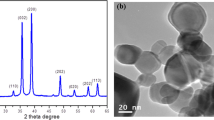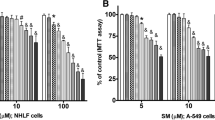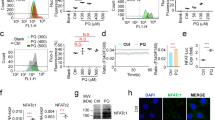Abstract
Backgrounds
The 5-chloro-2-methyl-2h-isothiazolin-3-one and 2-methyl-2h-isothiazol-3-one (CMIT/MIT) are widespread biocides that commonly found in variety of water-soluble consumer products including dentifrice, germicide and shampoo etc. Recently, in Korea, it has been reported that general population was exposed to humidifier sterilizer with CMIT/MIT as disinfectant components, and eventually more than 530 victims had been suffered severe lung disease since they had used. Although it is known to be a certain risk factor threatening public health, it is unknown to be associated with pathological cellular- and molecular-mechanisms. Therefore, in this study, we investigated the cytotoxic effect of CMIT/MIT in mouse alveolar type II epithelial cells, MLE-12 cells.
Methods
MLE-12 cells were treated with CMIT/MIT (0-50 μM) for 24 hours.
Results
In MTT assay, cellular proliferation was significantly decreased in response to CMIT/MIT treatment. In western blot analysis, protein levels of BAX/Bcl-2 and cleaved caspase-3 were significantly increased. Moreover, cell cycle-related gene were also increased. In ELISA, CMIT/MIT increased the release of pro-inflammatory cytokine of TNF-α and IL-1β. Moreover, CMIT/MIT increased the phosphorylated-ERK1/2, phosphorylated-p38, and phosphorylated-JNK1/2 protein levels in MLE-12 cells.
Conclusion
These findings suggest that CMIT/MIT exposure induce the injury of alveolar epithelial cells with inflammatory response via the p38-JNK1/2-ERK1/2 signaling pathway.
Similar content being viewed by others
References
Cho, H. J. et al. Effects of a mixture of chloromethylisothiazolinone and methylisothiazolinone on peripheral airway dysfunction in children. PLoS One 12, e0176083 (2017).
Willliams, T. M. The mechanism of action of isothiazolone biosides. PPChem 9, 14–22 (2007).
Park, T. The humidifier disinfectant case and the legislative challenges of the 20th Congress. Environ Health Toxicol 31, e2016015 (2016).
Jung, H. N., Zerin, T., Podder, B., Song, H. Y. & Kim, Y. S. Cytotoxicity and gene expression profiling of polyhexamethylene guanidine hydrochloride in human alveolar A549 cells. Toxicol In Vitro 28, 684–692 (2014).
Park, D. U. et al. Types of household humidifier disinfectant and associated risk of lung injury (HDLI) in South Korea. Sci Total Environ 596-597, 53–60 (2017).
Song, J. A. et al. Polyhexamethyleneguanidine phosphate induces severe lung inflammation, fibrosis, and thymic atrophy. Food Chem Toxicol 69, 267–275 (2014).
Pelletier, G., Valli, V. E., Rigden, M. & Poon, R. Effects of a 28-day oral exposure to a 5-chloro-2-methyl-4-isothiazolin-3-one and 2-methyl-4-isothiazolin-3-one biocide formulation in Sprague-Dawley rats. Drug Chem Toxicol 37, 149–155 (2014).
Poon, R., Rigden, M., Edmonds, N., Charman, N. & Lamy, S. Effects of 5-chloro-2-methyl-4-isothiazolin-3-one and other candidate biodiesel biocides on rat alveolar macrophages and NR8383 cells. Arch Toxicol 85, 1419–1427 (2011).
Liu, Y., Kumar, V. S., Zhang, W., Rehman, J. & Malik, A. B. Activation of type II cells into regenerative stem cell antigen-1 (+) cells during alveolar repair. Am J Respir Cell Mol Biol 53, 113–124 (2015).
Franco-Montoya, M. L. et al. Pulmonary effects of keratinocyte growth factor in newborn rats exposed to hyperoxia. Am J Physiol Lung Cell Mol Physiol 297, L965–976 (2009).
Bai, Y. X., Fang, F., Jiang, J. L. & Xu, F. Extrinsic Calcitonin Gene-Related Peptide Inhibits Hyperoxia-Induced Alveolar Epithelial Type II Cells Apoptosis, Oxidative Stress, and Reactive Oxygen Species (ROS) Production by Enhancing Notch 1 and Homocysteine-Induced Endoplasmic Reticulum Protein (HERP) Expression. Med Sci Monit 23, 5774–5782 (2017).
Tojo, K. et al. Enhancement of glycolysis by inhibition of oxygen-sensing prolyl hydroxylases protects alveolar epithelial cells from acute lung injury. FASEB J 32, 2258–2268 (2017).
Frazier, W. J., Xue, J., Luce, W. A. & Liu, Y. MAPK signaling drives inflammation in LPS-stimulated cardiomyocytes: the route of crosstalk to G-protein-coupled receptors. PLoS One 7, e50071 (2012).
Schettgen, T. & Kraus, T. Urinary excretion kinetics of the metabolite N-methylmalonamic acid (NMMA) after oral dosage of chloromethylisothiazolinone and methylisothiazolinone in human volunteers. Arch Toxicol 91, 3835–3841 (2017).
Guimaraens, D., Conde-Salazar, L. & Gonzalez, M. A. Allergic contact dermatitis on the hands from chloromethylisothiazolinone in moist toilet paper. Contact Dermatitis 35, 254 (1996).
Chung, L. Y. Oxidative stress in mouse skin following application of contact allergenic 5-chloro-2-methyl-4-isothiazolin-3-one and oxazolone. Contact Dermatitis 52, 170–171 (2005).
Lee, H. et al. Blockade of RAGE ameliorates elastase-induced emphysema development and progression via RAGE-DAMP signaling. FASEB J 31, 2076–2089 (2017).
Jiang, C. et al. Serpine 1 induces alveolar type II cell senescence through activating p53-p21-Rb pathway in fibrotic lung disease. Aging Cell 16, 1114–1124 (2017).
Burnham, E. L., Janssen, W. J., Riches, D. W., Moss, M. & Downey, G. P. The fibroproliferative response in acute respiratory distress syndrome: mechanisms and clinical significance. Eur Respir J 43, 276–285 (2014).
Ok, S., Kang, J. S. & Kim, K. M. Cultivated wild ginseng extracts upregulate the anti-apoptosis systems in cells and mice induced by bisphenol A. Mol Cell Toxicol 13, 73–82 (2017).
Elmore, S. Apoptosis: a review of programmed cell death. Toxicol Pathol 35, 495–516 (2007).
Sutherland, L. M., Edwards, Y. S. & Murray, A. W. Alveolar type II cell apoptosis. Comp Biochem Physiol A Mol Integr Physiol 129, 267–285 (2001).
Teng, X. & Toyama, Y. Apoptotic force: active mechanical function of cell death during morphogenesis. Dev Growth Differ 53, 269–276 (2011).
Martin, T. R., Hagimoto, N., Nakamura, M. & Matute-Bello, G. Apoptosis and epithelial injury in the lungs. Proc Am Thorac Soc 2, 214–220 (2005).
Kamp, D. W. et al. Asbestos-induced alveolar epithelial cell apoptosis. The role of endoplasmic reticulum stress response. Am J Respir Cell Mol Biol 49, 892–901 (2013).
Fink, S. L. & Cookson, B. T. Apoptosis, pyroptosis, and necrosis: mechanistic description of dead and dying eukaryotic cells. Infect Immun 73, 1907–1916 (2005).
Martinou, J. C. & Youle, R. J. Mitochondria in apoptosis: Bcl-2 family members and mitochondrial dynamics. Dev Cell 21, 92–101 (2011).
Vosler, P. S., Graham, S. H., Wechsler, L. R. & Chen, J. Mitochondrial targets for stroke: focusing basic science research toward development of clinically translatable therapeutics. Stroke 40, 3149–3155 (2009).
Ooi, H. K. & Ma, L. Modeling heterogeneous responsiveness of intrinsic apoptosis pathway. BMC Syst Biol 7, 65 (2013).
Delbridge, A. R. & Strasser, A. The BCL-2 protein family, BH3-mimetics and cancer therapy. Cell Death Differ 22, 1071–1080 (2015).
Lee, Y. J. & Lee, S. H. Sulforaphane potentiates growth-inhibiting and apoptosispromoting activities of cisplatin following oxidative stress and mitochondrial dysfunction in malignant mesothelioma cells. Mol Cell Toxicol 12, 289–299 (2016).
Mason, R. J. Biology of alveolar type II cells. Respirology 11 Suppl, S12–15 (2006).
Desai, T. J., Brownfield, D. G. & Krasnow, M. A. Alveolar progenitor and stem cells in lung development, renewal and cancer. Nature 507, 190–194 (2014).
Li, X., Shu, R., Filippatos, G. & Uhal, B. D. Apoptosis in lung injury and remodeling. J Appl Physiol (1985) 97, 1535–1542 (2004).
Kim, E. M. et al. The p53/p21 complex regulates cancer cell invasion and apoptosis by targeting Bcl-2 family proteins. Cancer Res 77, 3092–3100 (2017).
Poreba, M., Strozyk, A., Salvesen, G. S. & Drag, M. Caspase substrates and inhibitors. Cold Spring Harb Perspect Biol 5, a008680 (2013).
Wada, T. & Penninger, J. M. Mitogen-activated protein kinases in apoptosis regulation. Oncogene 23, 2838–2849 (2004).
Wang, L., Du, F. & Wang, X. TNF-alpha induces two distinct caspase-8 activation pathways. Cell 133, 693–703 (2008).
Raupach, B., Peuschel, S. K., Monack, D. M. & Zychlinsky, A. Caspase-1-mediated activation of interleukin-1beta (IL-1beta) and IL-18 contributes to innate immune defenses against Salmonella enterica serovar Typhimurium infection. Infect Immun 74, 4922–4926 (2006).
McIlwain, D. R., Berger, T. & Mak, T. W. Caspase functions in cell death and disease. Cold Spring Harb Perspect Biol 5, a008656 (2013).
Kim, E. K. & Choi, E. J. Pathological roles of MAPK signaling pathways in human diseases. Biochim Biophys Acta 1802, 396–405 (2010).
Kil, K. H., Kim, M. R., Kim, J. H., Jung, Y. J. & Cho, H. H. Analysis of ovarian gene expression in F2 mouse following perinatal exposure to DEHP via the parenteral route. Mol Cell Toxicol 12, 421–427 (2016).
Samara, K. D. et al. Upregulation of citrullination pathway: From Autoimmune to Idiopathic Lung Fibrosis. Respir Res 18, 218 (2017).
Author information
Authors and Affiliations
Corresponding author
Rights and permissions
About this article
Cite this article
Lee, J., Lee, H., Jang, S. et al. CMIT/MIT induce apoptosis and inflammation in alveolar epithelial cells through p38/JNK/ERK1/2 signaling pathway. Mol. Cell. Toxicol. 15, 41–48 (2019). https://doi.org/10.1007/s13273-019-0005-0
Received:
Accepted:
Published:
Issue Date:
DOI: https://doi.org/10.1007/s13273-019-0005-0




